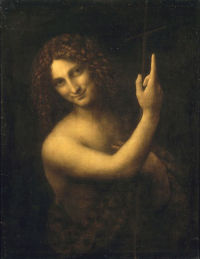Light and Vision Click on the thumbnails to explore the trail
Read more about this trail (expand)
According to Leonardo, the most important of the five senses was sight, the eye being the “window of the soul”. Leonardo thought a great deal about how the eye functioned and how we experience the world in terms of light and shade. His studies of the effects of light on form provided the basis for a revolution in the way that light, colour and space were described in painting.

- Enlarge
- Zoom & explore
- Photo RMN - © Hervé Lewandowski
St John the Baptist 1508-16
As his optical studies increased, Leonardo expressed doubts concerning linear perspective. While it was a logical system it did not correspond in reality to our perception of the world. In his later works, the impression of relief is the product of the optical relationship between the figure and the background, as the interaction of light and shade becomes all-important.
In St John the Baptist, Leonardo avoids the absolute definition of space by setting the figure against a dark background. A profound sensation of three-dimensional form has been created through the use of chiaroscuro.
Leonardo was aware of the inherent dangers of this system. Earlier in his notes he warned that a figure will not be discerned against a dark background and will not appear to be detached from it. From a distance nothing will be visible but the illuminated parts. However, in the shadows of the body of St John the Baptist, Leonardo has retained just enough light for us to be able to comprehend his form fully. As in the moon, even the dark areas of his figure retain a “slight glimmer” of reflected radiance.
In Leonardo's words
The first intention of the painter is to make a flat surface display a body as if modelled and separated from this plane, and he who most surpasses others in this skill deserves most praise. This accomplishment, with which the science of painting is crowned, arises from light and shade, or we may say chiaroscuro.
Derived from a lost Leonardo painting of the Angel of the Annunciation, St. John proclaims the arrival of Christ directly to the spectator, exuding an air of cosmic mystery in this small painting.
The atmospheric mood of the work is largely due to the impressive use of sfumato, or “smoky” effect, achieved by Leonardo through technical experiment and the scientific study of light and shade during the final years of his career. By applying layers of thin translucent varnish, the artist created a wide range of shadows, blurring the contours into soft transitions between light and shade to achieve an unprecedented plasticity in the figure.
St. John appears to be illuminated by an unknown light source outside the painting, as gentle shadows imbue his skin with a soft and delicate appearance. As God’s witness, the painting gives visual form to the first verses of St. John’s Gospel, which describe the one who was sent to bear witness to the “light that shineth in the darkness”.
- Medium Oil on wood panel
- Size 69 x 57 cm
- Location Musée du Louvre










